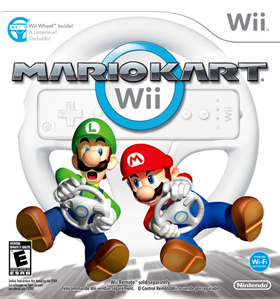Hi guys! This week we were looking at the idea of games based learning and how it can be used in the education of school children, we also looked very briefly at the SHANARRI Wheel. So today we had a go of using a Nintendo Wii, hence the title, on which we played Mario Kart, one of my all-time favourite games. We had a play about on it for about an hour so that everyone got a chance to race and get a feel for the game. After we had all had a turn playing the game we were set the task of creating a lesson plan around Mario Kart. We were to create different activities for maths, literacy, technology and any other subject we cold think of. Here are a few of the ideas my group came up with:
- The children are to create their own racing character, they are to draw them, give them a name, describe them and give them a racing uniform. Then they are to design their characters car, colour it in and give it a name if they would like. This comes under literacy and art as they have to use their literacy skills to describe their character and then their art skills are being used to physically create the character on paper with pen.
- The children are given some maths questions for example; Yoshi comes 1st, 4th and 7th. What is his average place in the race? You could also move it up a step by creating a table of points that are awarded for the different positions e.g. 1st place = 12 points, 2ndplace = 11 points, 3rd place = 10 points etc. and asking similar questions and getting the children to work out the total number of points the character collected.
- Another activity is that the children use their character and create a story using them and any other characters from the game. This is using their literacy skills as they have to use their imagination to create an interesting story.
- This activity would probably take quite a while to do but in the end I’m sure the children will love you for it. In small groups the children either pick the best character that each child has created or they create a new one in their groups and design a car and uniform for their character. When they’ve done that they then begin to build their designs, so they can build a cardboard car and paint it the colours of their design. The teacher then creates a racecourse outside in the playground. When all the groups have finished building their cars they go outside and race around the track. This doesn’t just utilise the children’s imagination and art skills but also their physical education is being used too.
As well as looking at various different activities you could do with these kinds of games, we looked at the SHANARRI wheel. The SHANARRI wheel focuses on children’s health and well-being in the learning environment. SHANARRI stands for;
Safe
Healthy
Active
Nurtured
Achieving
Respected
Responsible
Included
The four capacities and the SHANARRI wheel go together hand in hand, they are another important thing for a teacher to know to be effective. The four capacities are:
- Confident Individuals
- Successful Learners
- Effective Contributors
- Responsible Citizens
I think games based learning is quite a good thing to use, it can increase motivation, grab attention, reinforce knowledge and is fun for the kids too. However, I do think that its uses are limited. For as many games that there are, a small number of them are 1. Age appropriate and 2. Usable in a learning environment. A lot of the games don’t have the content to be able to build up any educational activities for example, Fifa, Call of Duty, Resident Evil and other games along those lines. Not only are they not age appropriate but they have no educational properties within them. So you do have to be careful with what games you choose and always ask for parental permission if the game is set at an age that is older than the children in your class.
The Teach Though Staff say that there are six benefits of game-based learning, these benefits are:
- Increases a child’s memory capacity, this is because games often revolve around the utilisation of memorisation so as to solve the puzzle or win the game.
- Computer and simulation fluency is benefited as it helps the children to understand how a computer works, making it second nature to them.
- Helps with fast strategic thinking and problem solving as most games require children to think quickly and to utilise their logic so as to know what will happen three steps later. It also helps the children to think outside the box and to think on their feet.
- Develops hand-eye coordination as they have to be watching the screen and using their hands to manoeuvre a character or vehicle etc. at the same time.
- Beneficial for children with attention disorders as it can keep them focused on something fun while they learn.
- Helps improve skill building e.g map reading as a lot of games have certain aspects which help children with specific skills. For example, lot of mystery and adventure games contain maps which the children have to navigate so as to move on to the next stage, also some games have money aspects ans this can help the children understand the value for money and the importance of being careful with what you spend it on.
Until next time
Chloe x



